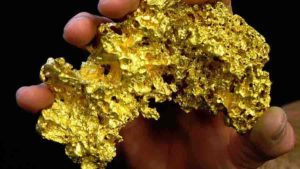
What is Gold Nuggets?
A gold nugget is a naturally occurring piece of native gold. Watercourses often concentrate nuggets and finer gold in placers. Nuggets are recovered by placer mining, but they are also found in residual deposits where the gold-bearing veins or lodes are weathered. Nuggets are also found in the tailings piles of previous mining operations, especially those left by gold mining dredges.
How Do Gold Nuggets Form?
Many Nuggets Gold formed as clusters of gold crystals from very hot water in cracks and fissures in hard-rocks, often with quartz. Later, weathering released the gold nuggets that end up in a stream due to gravity.
Nuggets are gold fragments weathered out of an original lode. They often show signs of abrasive polishing by stream action, and sometimes still contain inclusions of quartz or other lode matrix material. A 2007 study on Australian nuggets ruled out speculative theories of supergene formation via in-situ precipitation, cold welding of smaller particles, or bacterial concentration, since crystal structures of all of the nuggets examined proved they were originally formed at high temperature deep underground (i.e., they were of hypogene origin).
Other precious metals such as platinum form nuggets in the same way. A later study of native gold from Arizona, US, based on lead isotopes indicates that a significant part of the mass in alluvial gold nuggets in this area formed within the placer environment.
What Is The Composition Of Gold Nuggets?
Nuggets are usually 20.5K to 22K purity (83% to 92% by mass). Gold nuggets in Australia often are 23K or slightly higher, while Alaskan nuggets are usually at the lower end of the spectrum. Purity can be roughly assessed by the nugget color, the richer and deeper the orange-yellow the higher the gold content.
Are Gold Nuggets Pure Gold?
Most nuggets are between 85 percent and 95 percent pure gold, but the remainder can be one of several kinds of minerals. Nuggets in laterite can be either reddish or black; nuggets in quartz appear cloaked with white. Any nuggets not deemed to be “jewelry-grade” get melted down and sold as pure gold.
What Is A Nugget Of Gold Worth?
A specimen gold nugget is a matrix of gold and other rock, usually quartz or ironstone (in Australia). If the gold to rock ratio is high, and the shape shows off a lot of the gold at the surface, your nugget can hold a higher value. The largest specimen gold nugget in the world to this date is the Holterman Nugget found in Australia at Hill End, NSW in 1872 weighing in at 285 kg.
Where Are Gold Nuggets Found?
It found in residual deposits where the gold-bearing veins or lodes are weathered. Nuggets are also found in the tailings piles of previous mining operations, especially those left by gold mining dredges.
The best areas for finding gold nuggets are those which are known for producing coarse gold. The term “coarse” is used to describe gold pieces which range in size from a wheat grain to many grams. Scanning with a metal detector is the most common, practical method for finding gold nuggets and other forms of gold.
Coarse gold did not occur in all gold fields, even when some were considered especially rich. In some areas of Australia the gold is fine and concentrated in crevices in bedrock and any gravel wash overlying this. A metal detector cannot pick up this fine gold sprinkled through sand and gravel, nor can it detect minute traces of gold still enclosed in quartz reef material.
“Related: Where Was The Most Gold Found In The United States? ”
What Are the largest Gold nuggets in the world?
Two gold nuggets are claimed as the largest in the world: the Welcome Stranger and the Canaã nugget, the latter being the largest surviving natural nugget.
Welcome Stranger Nugget
The Welcome Stranger was found at Moliagul, Victoria, Australia in 1869 by John Deason and Richard Oates. It weighed gross, over 2,520 troy ounces (78 kg; 173 lb) and returned over 2,284 troy ounces (71.0 kg; 156.6 lb) net.[6] The Welcome Stranger is sometimes confused with the similarly named Welcome Nugget, which was found in June 1858 at Bakery Hill, Ballarat, Australia by the Red Hill Mining Company. The Welcome weighed 2,218 troy ounces (69.0 kg; 152.1 lb). It was melted down in London in November 1859.
Canaã Nugget
The Canaã nugget, also known as the Pepita Canaa, was found on September 13, 1983 by miners at the Serra Pelada Mine in the State of Para, Brazil. Weighing 1,955 troy ounces (60.8 kg; 134.1 lb) gross, and containing 1,682.5 troy ounces (52.33 kg; 115.37 lb) of gold, it is among the largest gold nuggets ever found, and is, today, the largest in existence.
The main controversy regarding this nugget is that the excavation reports suggest that the existing nugget was originally part of a nugget weighing 5,291.09 troy ounces (165 kg; 363 lb) that broke during excavations. The Canaã nugget is displayed at the Banco Central Museum in Brazil along with the second and third largest nuggets remaining in existence, weighing respectively 1,506.2 troy ounces (46.85 kg; 103.28 lb) and 1,393.3 troy ounces (43.34 kg; 95.54 lb), which were also found at the Serra Pelada region.
The largest gold nugget found using a metal detector is the Hand of Faith, weighing 875 troy ounces (27.2 kg; 60.0 lb), found in Kingower, Victoria, Australia in 1980.










